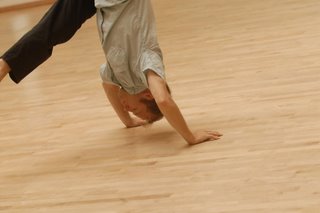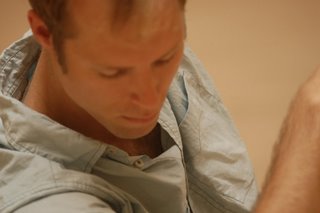Connecting dots from the 20th century
I am humbled, inspired and influenced by the artists who are committed to pushing the boundaries of their chosen forms – trying to address the fundamental issues of live art: content vs. abstraction, form vs. process and the audience and performer relationship.
Why are we making work?
How do we translate what we make to those we share it with?
I have been very influenced by work that references its own creation. A perspective that values the messiness of process, and recognizes that the story of the process, in the end, becomes the gold of the work.
When successful, dance/art can open up a satisfying paradox – producing work that feels simultaneously disorientating and familiar. That is the balance that I strive for– the state of being lost and found all at the same time.
I thought that it would be appropriate to mention just a few of the predecessors that have had a deep influence on me choreographically. This is by no means a proper, or completely accurate historical chronology, but rather, some of the dots that I have connecting over the course of the past fifteen years. Not listed in this passage are numerous teachers, choreographers and the many somatic/improvisation-based artists that have had their own deeply enriching imprint on me.
The list:
Vaslav Nijinsky - an innovative choreographer and performer. He defied conventional expectations and opened the door for a re-definition of what ‘classical ballet’ is. He is modern. He was already boldly hybridizing the classical and modern forms several decades before his time.
Oskar Schlemmer - was a multi-media artist who for a period of time directed the Bauhaus School. He established the first Performance Art program for a college. He was a sculptor who directed dancers to interact with his sculptures, evolving into a choreographer. He evolved into a choreographer and produced many interdisciplinary dance performances and installations.
Bertolt Brecht - wove self-reference into his plays and foresaw post-modernism and Dance-Theater. He was an innovator for the theater using interdisciplinary practices and was a controversial advocate for socialism. He even incorporated film projections into his plays back in the 1930’s (I find that interesting as it somehow still seems contemporary to use projections in live performance all these years later).
Marcel Duchamp - with his Ready Made theories, exposes a new frontier for artistic expression. From him on, the can of worms is open and everything can be deemed art if you see it as such.
George Balanchine - is creating works that strip away all sentimentality and décor creating a pure and minimal ballet form - Neo-Classical Ballet.
John Cage - puts Duchamp’s notions into practice and follows a methodology that champions the elements of randomness, chance, coincidence and accident, among others.
Robert Ellis Dunn - who was an assistant to Cage and an accompanist for the Merce Cunningham Dance Company, took Cages process based ideas and translates them into movement composition classes that looked at improvisation as a legitimate form in itself. For several years during the early sixties, he worked with a group of young dancers who gave their first public presentation of these sessions at the Judson Church in New York. The group went on to notoriety as the Judson Church Group and progresses dance into a new Post-Modern era.
I find it fascinating that there isn’t more popular acknowledgement of Dunn’s contribution. It seems that so much would never have happened if it weren’t for him.
Steve Paxton and Trisha Brown - both dancers from the Judson Church Group and the Grand Union, went on to contribute some of the most important developments in dance, notably Contact Improvisation, Release Technique and System based choreographies.
Pina Bausch - begins to produce large-scale theatrical works that become associated with the development of Dance-Theater. It will draw heavily from its lineage from earlier German expressionist pioneers such as Brecht, Laban and the Bauhaus, amongst others. Her vision has pretty much influenced every theater and dance director working today.
William Forsythe – receiving influence from the work of Laban, Brecht and Trisha Brown plus philosophical and architectural studies, went on to infuse these sources into a language that used the classical ballet syllabus as the raw vocabulary to speak through the voice of improvisation. He created a new paradigm and busts open certain conventional attitudes towards how Classical Ballet is viewed and thus makes the big leap – bridging Classical Dance forms and Post Modern processes. He has attempted to strip the culture of ballet from the function of ballet, reducing it to its bare linguistic material. That is in essence a post-modern premise. The independently pointed directions of Classical and Modern dance ideas converge.
This brings us to the point in contemporary (presentational & ballet-based) dance where some of us find ourselves today. We are classically trained and are producing interdisciplinary work, improvising and working on-site. We are speaking through classical vocabulary but it doesn’t resemble its original form anymore. We are emersing into the information of somatic and social practices. Basically, a new mindset is emerging. The older definitions of Modern or Classical are shifting again and the front edges of the waves of change carry a blurred face.
I feel very fortunate to be working at this time in dance history where the perspectives of form and process are being melded and we can move away from the binary mindset (ballet vs. modern – or - learned movements vs. natural movements ect…) that only seems to limit a truer potential for dance and human expression.




